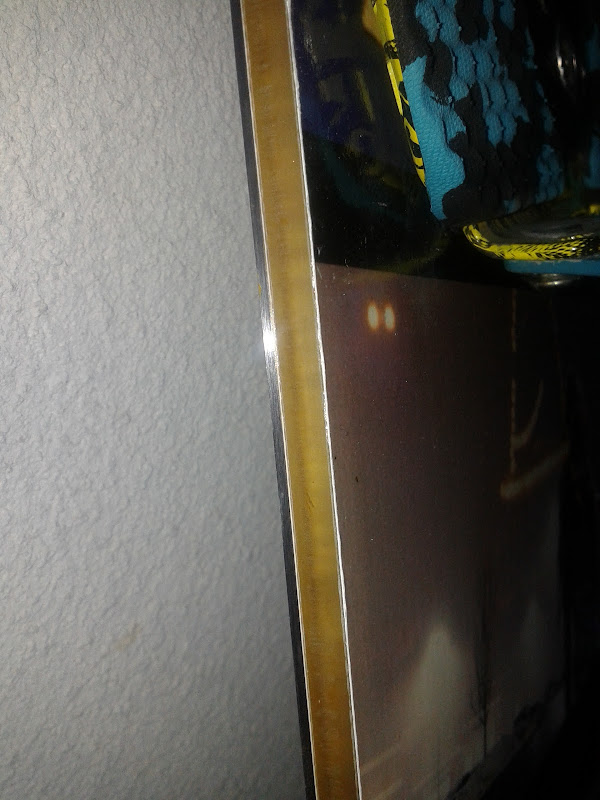sidewall bonding (again)
Moderators: Head Monkey, kelvin, bigKam, skidesmond, chrismp
Not sure if you already know/do this, but when you pour your urethane do you pour high above the part in a very thin stream. This forces many bubbles to escape before entering the part. If you have the time you can also pour into a second cup first and by pouring against the side bubbles are evacuated (like pouring beer).
As far as pulling a vacuum, how about a venturi for your compressor (by hand could be a long process)? Lots of times a polycarbonate plate is placed over a heavy duty mixing tub (with a gasket) to pull a degassing vacuum.
As far as pulling a vacuum, how about a venturi for your compressor (by hand could be a long process)? Lots of times a polycarbonate plate is placed over a heavy duty mixing tub (with a gasket) to pull a degassing vacuum.
-
skidesmond
- Posts: 2338
- Joined: Tue Apr 07, 2009 3:26 pm
- Location: Western Mass, USA
- Contact:
Chris,chrismp wrote:do it like me folks!
i route a channel into the core, pour in some 95A polyurethane resin (adiprene LF950A with e300 hardener...cures well at room temp even if a 16h postcure is recommended! i had the tech guys at chemtura do some testing for me), plane.
sidewalls are the toughest out there and they stick to the core and epoxy like nothing else. plus, you can produce seamless sidewalls/tipspacers. and the stuff is cheaper than buying uhmw sheets. and can be colored with regular epoxy pigments.
Question on your pic. I see you created a channel and filled it w/ poly resin. But I don't see how that makes a side wall. Do you flip the board over and plane the board to the specified profile until you see the poly resin? How well does the poly resin plane? Any chipping or tearing?
Any more pics of a finished core?
Thanks
- FigmentOriginal
- Posts: 142
- Joined: Mon Oct 24, 2011 1:13 pm
- Location: New England USA
- Contact:
steve, you're spot on! i flip the core over and plane the underside till the urethane shows. usually takes very few passes. then i flip the core over and profile it with a planer jig.
the urethane machines nicely without any tearouts or melting. it doesn't even need flame treating to bond well. the planer gives it a slightly rough surface which is sufficient.
i've built five boards with that type of sidewall and none of them show signs of delamination, even after some heavy park rail abuse.
here's a closeup of the sidewall finish with a router bit (for more pics look at my journal thread):

the urethane machines nicely without any tearouts or melting. it doesn't even need flame treating to bond well. the planer gives it a slightly rough surface which is sufficient.
i've built five boards with that type of sidewall and none of them show signs of delamination, even after some heavy park rail abuse.
here's a closeup of the sidewall finish with a router bit (for more pics look at my journal thread):

-
skidesmond
- Posts: 2338
- Joined: Tue Apr 07, 2009 3:26 pm
- Location: Western Mass, USA
- Contact:
Wow, that looks really nice. I like the wood side walls. I'm still undecided if the masses will find wood side walls too much maintenance, since they are so used to having plastic sidewalls. Too me the only maintenance on wood is a quick wipe down after skiing and annual maintenance. But how many do that?
Good to know there's an alternative to plastic side walls that doesn't look too difficult to do.
Maybe I found another use for my Mirror Coat epoxy.
Good to know there's an alternative to plastic side walls that doesn't look too difficult to do.
Maybe I found another use for my Mirror Coat epoxy.
What kind or urethane resin do you use?
Fighting gravity on a daily basis
www.Whiteroomcustomskis.com
www.Whiteroomcustomskis.com
Fighting gravity on a daily basis
www.Whiteroomcustomskis.com
www.Whiteroomcustomskis.com
- FigmentOriginal
- Posts: 142
- Joined: Mon Oct 24, 2011 1:13 pm
- Location: New England USA
- Contact:
@vinman: i can't really tell if this resin would work. it seems a bit hard for me though. i'm using a 95A hardness resin since this is what ride snowboards uses.
their pmc-790 resin seems more suitable, but you better give them a call and ask about the properties of their resin systems in cold conditions. many polyurethanes get brittle at low temps.
@figment: i leave the core completely square the entire process. the excess just gets cut off with the flash. the channel i route into the core is 1/2 inch wide and roughly half of it gets trimmed with the flashing.
their pmc-790 resin seems more suitable, but you better give them a call and ask about the properties of their resin systems in cold conditions. many polyurethanes get brittle at low temps.
@figment: i leave the core completely square the entire process. the excess just gets cut off with the flash. the channel i route into the core is 1/2 inch wide and roughly half of it gets trimmed with the flashing.


